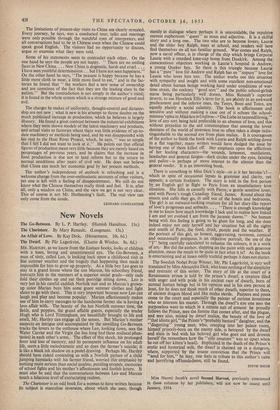Chinese Grey
Window on China. By Raja Hutheesing. (Verschoyle. 12s. 6d.) MR. HUTHEESING made two visits to China, the first in 1951 at the invitation of the India-China Friendship Association and again in 1952 as a correspondent of the Press Trust of India attached to the Indian Cultural Delegation. He went as a socialist eager to learn whether China has anything to teach India in her struggle against poverty and oppression, but he found a Communist dictatorl ship whose ruthless methods he could not accept. He was a constant embarrassment to the Chinese authorities because he persisted in asking awkward questions-and tried to see things for himself
The limitations of present-day visits to China are clearly revealed. Every journey, he says, was a conducted tour, talks and meetings were only possible through the watchful eyes of interpreters, and all conversations had to be in Chinese even when the Chinese could speak good English. The visitors had no opportunity to discuss, argue or examine what they were told.
Some of his statements seem to contradict each other. On the one hand he says the people are not happy. " There are no smiling faces in New-China. ... New China is dogmatic, harsh and cruel. .. . I have seen youthful determination ... but I have not seen happiness." On the other hand he says, "The peasant is happy because he has a little more cloth to wear, a little more food to eat," and in the fac- tories he found that " the workers feel a new sense of ownership and are conscious of the fact that they are the leading class in the nation." But the contradiction is not simply in the author's mind; it is found in the whole system which is a strange mixture of good and evil.
The charges he makes of uniformity, thought-control and dictator- ship are not new ; what is new is his attempt to throw doubts on the much publicised increase in production, which he believes is largely illusory. He found a great contrast between the industrial exhibitions where they were shown models of the latest machinery and products, and actual visits to factories where there was little evidence of up-to- date machinery or methods being used, and he was disappointed with his visit to the Huai River Project, which, he says, " was so simple that I felt I did not want to look at it." He points out that official figures of production mean very little because they are merely based on percentages of previous years, and he claims that the increase in food production is due not to land reform but to the return to normal conditions after years of civil war. He does not believe that China can reach her economic goal by her present methods.
The author's independence of .outlook is refreshing and is a welcome change from the over-enthusiastic accounts of other visitors, yet one is left with a feeling of disappointment. We still do not know what the Chinese themselves really think and feel. It is, after all, only a window on China, and the view we get is not very clear. This of course is not Mr. Hutheesing's fault. The real view can only come from the inside.
LEONARD CONSTANTINE



































 Previous page
Previous page